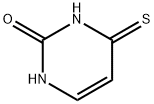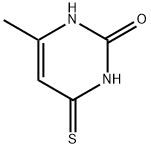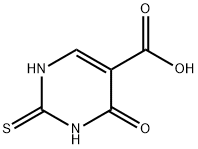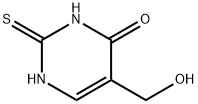4-Thioxo-3,4-dihydropyrimidin-2(1H)-one , 98% , 591-28-6
Synonym(s):
2-Hydroxy-4-mercaptopyrimidine
| Pack Size | Price | Stock | Quantity |
| 250mg | RMB102.40 | In Stock |
|
| 1g | RMB266.40 | In Stock |
|
| 5g | RMB1313.60 | In Stock |
|
| others | Enquire |
PRODUCT Properties
| Melting point: | 295 °C (dec.) (lit.) |
| Density | 1.368 (estimate) |
| refractive index | 1.7000 (estimate) |
| storage temp. | Store at -20°C |
| solubility | 1 M NaOH: soluble50mg/mL |
| form | Powder |
| pka | 5.38±0.20(Predicted) |
| color | Yellow |
| InChI | InChI=1S/C4H4N2OS/c7-4-5-2-1-3(8)6-4/h1-2H,(H2,5,6,7,8) |
| InChIKey | OVONXEQGWXGFJD-UHFFFAOYSA-N |
| SMILES | C1(=O)NC=CC(=S)N1 |
| CAS DataBase Reference | 591-28-6(CAS DataBase Reference) |
Description and Uses
4-Thiouracil is a site-specific, photoactivatable probe used to detect RNA structures and nucleic acid-nucleic acid contacts. It absorbs ultraviolet light >300 nm and, in the presence of oxygen, acts as an energy donor to produce singlet oxygen by triplet-triplet energy transfer. The highly reactive oxygen species then reacts readily with 4-thiouracil, leading to the production of uracil and uracil-6-sulfonate, which is fluorescent at a wavelength of ~390 nm. 4-Thiouracil is used as a T. gondii uracil phosphoribosyltransferase substrate to produce 4-thiouridine monophosphate, which can ultimately be incorporated into RNA.
4-Thiouracil is suitable reagent employed in Schneider′s media for the embryos during RNA extraction. It may be employed as reagent for the Northwestern blotting technique.
Safety
| Symbol(GHS) |  GHS07 |
| Signal word | Warning |
| Hazard statements | H302+H312+H332 |
| Precautionary statements | P261-P264-P280-P301+P312-P302+P352+P312-P304+P340+P312 |
| Hazard Codes | Xn |
| Risk Statements | 20/21/22 |
| Safety Statements | 36 |
| WGK Germany | 3 |
| HS Code | 29335990 |





